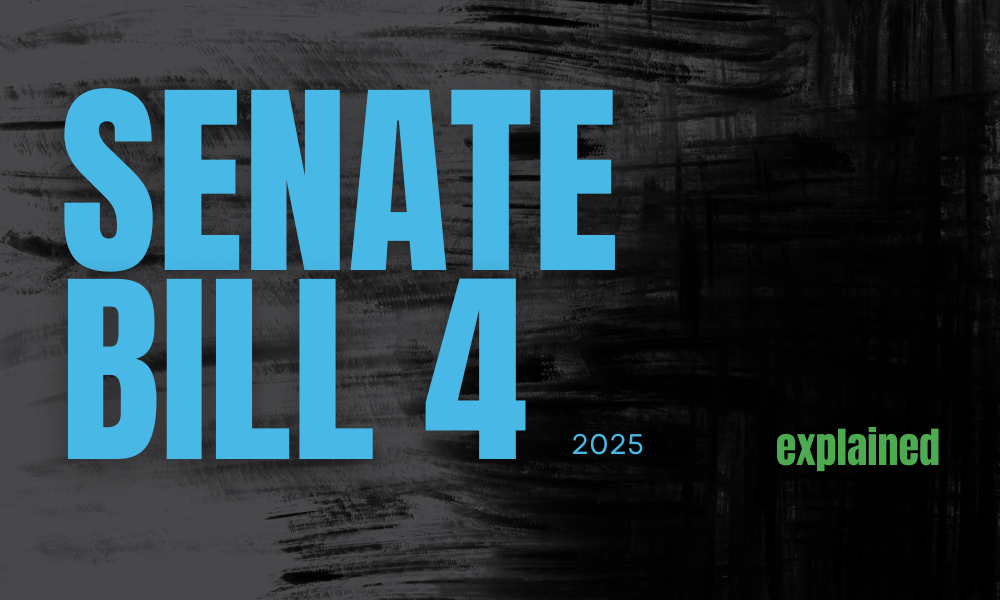During the 2025 session, the Missouri Legislature passed Senate Bill 4 (or SB4), which – among other things – introduced new accounting mechanisms through which utility companies in our state can more quickly raise their rates. SB4 also included some provisions relating to “large load consumers,” which include hyper-scale data centers and large scale manufacturers. In this blog post, MCE will break down what the new law does and does not do.
This post uses a lot of jargon and acronyms, so we’ve included a glossary at the bottom to help clarify terms. If you’d like to read the legislation yourself, it’s available via this link.
What it does:
SB4 is a large bill that changes Missouri’s energy landscape. From an environmental perspective, it does not change things for the better. Most of the legislation creates new ways that investor-owned utilities can raise their rates faster for all customers.
One of those methods is called Construction Work in Progress, or CWIP for short. Before SB4, utilities had to have new plants complete and online–actually providing customers with energy–before they could charge consumers for their construction. Under the new law, some utilities can charge you for their construction costs before a single kilowatt is produced. There are no penalties for companies that fail to complete their projects on time or within budget. There are also no penalties if the utility fails to complete the project at all. This means your bill can go up without you receiving any benefit for those increases. The CWIP provision applies specifically to methane gas and nuclear generation projects put forward by electric companies, like Ameren and Evergy.
The future test year provision of the bill similarly allows utilities to charge more without providing any benefit to consumers. This accounting measure applies specifically to water and gas companies, like Spire and Missouri American Water, not electric companies. Historically, utilities have had to justify their requested rate increases by providing proof based on past costs that can be verified. Under SB4’s future test year scheme, the company can conjure an imaginary projection of what their costs might be over a 12 month period in order to justify how much more they want to charge customers. This strongly incentivizes companies to over estimate their costs and spend more to avoid having to return unspent funds to consumers.
In addition, SB4 makes regulatory changes that incentivize methane gas (or “natural gas”) production and disfavor renewable energy. The watt-to-watt portion of the bill requires that utilities have “an equal or greater amount of reliable electric generation” online before an old plant can be taken offline. The law does not define “reliable,” instead deferring to the Missouri Public Service Commission (PSC) to do so. Additionally, SB4 changed the Integrated Resource Planning (IRP) process, the method through which utilities outlined their medium-term goals for how to meet expected demand. Previously, IRP planning occurred every three years and details were governed by the PSC. Under the new law, state statute has specific requirements and allowances for IRP planning. IRPs are now to be submitted to the PSC every four years. IRP approval from the PSC now constitutes permission for the utility to construct projects therewithin. Additionally, PSC investigation into new Certificates of Convenience and Necessity (CCNs), or paperwork a utility is required to complete demonstrating that a new generation facility is actually needed, is limited and expedited as long as it shows alignment with the company’s IRP. CCNs are also now allowed to include CWIP in the base rate charged for power from the new facility in question.
SB4 included some minor wins for consumers. It expanded the state’s hot and cold weather rules so that utilities cannot shut off someone’s power within 72 hours of an extreme forecast. From June 1 to September 30, the threshold is 95 degrees F or a heat index of 105 degrees F. Between November 1 and March 31, it is a forecast of 32 degrees F that triggers the rule. The legislation also allows for the PSC to create a low income consumer class based on energy burden. Energy burden refers to the percent of a household’s income spent on utility bills. A household that spends 6% or more of their income on energy is considered to have a high energy burden [1]. SB4 does not define an acceptable energy burden threshold. Technically, SB4 does include a large consumer load provision, but it is riddled with loopholes.
What it does not do:
Despite the large load section of the law, SB4 does not guarantee that data center costs will not be pushed onto residential consumers. The accounting mechanisms outlined above make it easier for utilities to finance projects that will attract data centers and incentivizes them to raise residential rates in order to pay for new generation infrastructure. Ameren and the PSC are already utilizing the expedited proposal process to hurry along yet another methane gas plant at the former Rush Island coal plant site.
Several loopholes in the large load consumer section of SB4 will allow the utilities to pass off the cost of building infrastructure onto average consumers. The law prohibits “unjust or unreasonable” cost increases from being passed from large load users to residential customers, but leaves it to the PSC to define those terms. Additionally, “large load consumers” are defined as using 100 MW or more, which roughly equals the energy use of 16,400 U.S. homes [2]. Data centers can range from a few MWs to hundreds, so all this does is encourage companies to build multiple 99 MW or smaller facilities in order to avoid compliance. For example, two 60 MW centers built by the same company on the same land wouldn’t trigger SB4’s large load provisions.
Finally, it does nothing to prevent the harm data centers do to water quality, air quality, and quality of life where they’re built. There is no provision in SB4 requiring large load customers like data centers use renewable energy. As a result, companies are building more fossil fuel infrastructure in order to attract data center customers and passing the costs along to consumers.
Ameren, City Utilities of Springfield, Evergy, Spire, Liberty Electric, Summit Utilities, and multiple industry groups representing the interests of utility profit maximization voiced their support for SB4 throughout the legislative process. Every single voice that testified in favor of the legislation represented industry. Meanwhile, consumer and environmental protection groups, including AARP, Consumers Council of Missouri, Empower Missouri, MCE, the Missouri Veterans Initiative, Renew Missouri, and Sierra Club, along with 95 individual Missourians testified in opposition.
The Elephant in the Room: The PSC
Many of the key portions of SB4 that could potentially protect consumers require the PSC to write the details for how the protections will work. The PSC is not a consumer-friendly organization. We are already seeing their pro-fossil fuel, pro-industry attitude work against the public interest. The PSC denied requests for in-person hearings with no explanation or reasoning for the upcoming Ameren methane gas plant proposal at the former Rush Island coal plant site [3]. Each commissioner makes over $100,000 per year and is appointed by and serves at the pleasure of the governor [4]. Our current governor received more than $400,000 in campaign contributions from utilities [5]. It’s no surprise, then, that the PSC generally approves rate increases; the last two requested by Ameren (in 2023 and 2025) were approved unanimously. The Commission approved rate increases for Spire and Evergy this year, too. Perhaps most alarmingly, MCE staff who were present at the Senate hearing for SB4 witnessed current the PSC Chair testify in favor of the legislation.
Conclusion:
SB 4 does not protect Missourians from increasing bills that will ultimately fund data centers. Right now, Ameren is back in front of the PSC asking to build more fossil fuel infrastructure, likely to power or attract more data centers. If you want to speak out against the project, join us on Thursday, October 30 at 6pm by going to webex.com and using meeting code 2861 760 0841, password 0238. You can submit a written comment to the PSC too. Login to your account or create a new one via this link and reference file no. EA-2025-0238. Further details for how to submit written comments can be found here. You can also contact Governor Mike Kehoe’s office to demand that he fill the open seat on the PSC with someone who champions consumers and the environment. Together, we can stop industry from using our data centers as an excuse to lock us into decades of fossil fuel use in our state.
Alphabet Soup: The Glossary
CCN Certificate of Convenience and Necessity. This is a process utilities have to go through to prove the infrastructure they want to build is needed.
CWIP Stands for Construction Work in Progress. An accounting method through which companies can charge consumers for energy plant construction before plants are completed.
FTY Stands for Future Test Year. an accounting method through which utilities can charge you based on a guess of what their costs might be in the future instead of using real, past data.
IRP Stands for Integrated Resource Plan. It represents the goals and plans utility companies have for what energy sources they will use over a period of time.
Methane gas A fossil fuel energy source that is primarily made of methane. Also called natural gas.
MW Stands for megawatt, a unit of electricity.
Natural gas A fossil fuel energy source that is primarily made of methane. Also called methane gas.
PSC Stands for the Public Service Commission. The five member board appointed by the governor to regulate investor-owned utilities in Missouri.
SB4 Senate Bill 4 from 2025.
Thank you to Christen Commuso, Maxine Gill, and James Owen for their review of this post for clarity and accuracy.
Endnotes:
[1] Cheatham, Tori, and Jenn DeRose. St. Louis Energy Burden Report: How Geography, Income, and Race Factor into Energy Costs for St. Louis Families. Sierra Club and Renew Missouri, Jan. 2025, https://www.sierraclub.org/sites/default/files/2025-01/stlouisenergyburdenreportjan2025_0.pdf.
Learn more about energy burden in Missouri via the Renew Missouri, Sierra Club, and Consumers Council Missouri Energy Burden Dashboard and report. https://app.power-d.city/dashboard/missouri
[2] “What Is a Megawatt? Megawatt-Hours & Conversions Explained.” EcoWatch, 14 Dec. 2023, https://www.ecowatch.com/solar/what-is-a-mega-watt.
[3] Nancy Dippell, Secretary and John T. Clark, Senior Regulatory Law Judge. “Order Modifying the Procedural Schedule and Denying Public Counsel’s Motion for an In-Person Local Public Hearing.” Missouri Public Service Commission, 11 Sep. 2025, https://efis.psc.mo.gov/Document/Display/848996. Case No. EA-2025-0238.
[4] Missouri MAP | Employee Details. https://mapyourtaxes.mo.gov/MAP/Employees/Employee/EmployeeDetails.aspx?last=hahn&first=&agency=0&row=115110&year=2025. Accessed 21 Oct. 2025.
[5] Kim, Jonathan. “Missouri Utilities Pump More than $400,000 into Kehoe Gubernatorial Bid.” Energy and Policy Institute, 16 Oct. 2024, https://energyandpolicy.org/missouri-utilities-support-kehoe-gubernatorial-campaign/.
[6] “Witness Appearance Form.” Missouri House of Represenatatives, 10 Mar. 2025, https://documents.house.mo.gov/billtracking/bills251/witnesses/SB4Testimony3-10.pdf. Chapter 610, RSMo.

